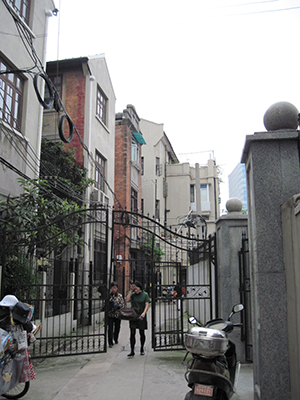
Westerners who have never been to China have a preconceived image of the masses of people and crowded chaotic streets portrayed by the media. These images certainly are part of the complex reality that is China, but upon entering one of the Shanghai lilongs, the visitor is confronted with another kind of reality. The lilong neighborhood, nestled within one of the new French concession superblocks, offers a sharply contrasting sense of security and quietness to the perimeter commercial activity.
Physically, the lilong neighborhoods are composed of a series of main lanes coming off of the commercial streets and perpendicular cross lanes connecting the residential units to the main lanes. These units are two and three story structures, attached side by side with small south-facing courtyards. Because all courtyards culturally should face south, the units are arranged front to back, as opposed to front to front as we are accustomed to in the west.
Trying to wrap my mind around the spatial organizing principles was a challenge, and for a while all I could cope with was understanding the physical. But walking around the lilong neighborhoods on yet another occasion, I began to make connections to the cultural and the social. The lilongs came in vogue in the late 19th century, when tens of thousands of migrants swarmed into Shanghai, putting a strain on housing stock and commercial stock. The movers and shakers in Shanghai regarded the city’s commercial frontage as one of its most valuable resources, and did not want immigrants to take over this frontage with residential use. The planners and architects therefore proposed a design solution of the superblock with a perimeter belt of commercial and housing in the hollow. This arrangement provided revenue to the city and protected residents from the noise and chaos of the city.
Indeed, walking through the lilongs, especially some of the better kept neighborhoods, I could see evidence of what an oasis they were in the city. Crossing over the threshold under the gate, the clamor of the busy commercial street died down and my blood pressure lowered. On the main lanes, some entrepreneuring souls had opened small stalls and were selling vegetable or small goods. Older people played chess at small tables while keeping half an eye on the small children playing with a toy car. The pace of life in the lilongs was definitely slower and more relaxed than that of the commercial streets and the residential towers that loomed over them. I could easily understand the allure the lilongs held for early Shanghai residents.
As a westerner, though, I could not help comparing the lilongs to another residential movement that took place around the same time. The Garden City movement had a lot of the same goals as the lilong: Provide better quality housing, give residents a safe, affordable place to live away from the dangers of the city, and promote economic growth. As good as Howard’s intentions were, however, the Garden City was in end-effect swallowed by the Garden Suburb. American suburbs, while not the single underlying factor to the demise of the post-war American city, did a fair amount of damage.
The lilongs, too, though created with the best intentions, were also in end effect detrimental to Shanghai. Because, though the experience inside the lilongs is a refreshing (especially the renovated ones like Tian ze Fang), getting to them is exhausting. Shanghai has lively commercial streets, especially compared to parts of some American cities. However, even the most lively street becomes excruciatingly long when it is interrupted by a cross street only once every 2000 meters. By the time you arrive at one of the lilong neighborhood gates, you feel drained. By making the dimensional jump from the small, walkable blocks seen in older portions of Shanghai to the extra large blocks, it set the precedent for superblocks as good urban planning-- a view Chinese developers can’t seem to break. This tendency created the swarming Shanghai we see today. There is a high concentration of people and mass, but without the walkability and pedestrian scale it is as overwhelming and unfriendly as the sprawling American City is underwhelming and hostile.
We are already beginning to see the signs of this detrimental thinking in the redevelopment of the lilong blocks. The superblocks set up a redevelopment precedent of mega developments—towers on a pedestal of green fluff that lack all of the charmed alleys of the lilong. The population and concentration in Shanghai and the rest of China is such that right now planners, architects and developers can do basically whatever they want and things will work. Because things in China move so fast, there isn’t enough time for anyone to sit back and say, “Hey, wait…are we doing the most sensitive sustainable urban design possible?” Thanks to an aging population and the one-child policy, the future Shanghai (and China) will look radically different. The government will not have the labor force to sustain the rapid economic growth the country has experienced in the last 20 years. Though this future is probably 100 years away, urban form has a very long shelf life. The flaws in the urban form will eventually become major problems and at that point, the government will not have any money to implement retrofits. It happened in America and will happen in China.
